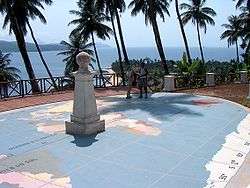Tropics
The tropics is the area in the world between the Tropic of Cancer and Tropic of Capricorn. Many, but not all, tropical regions have wet climates that are known as "tropical climates".
- Not to be confused with tropical rainforests, regions of the tropics that are covered by rainforest.
Understand
Geographical definition

The tropics include the following regions:
- The southern half of Mexico
- The Caribbean and Central America
- The northern half of South America
- Most of Africa
- The southern third of Middle East and southern half of India
- Southeast Asia and a small part of East Asia
- Oceania, except New Zealand and the southern half of Australia
At the Equator, day and night are about 12 hours each around the year, with pretty much no twilight (the sun rises and sets very rapidly). Elsewhere in the tropics the day and night differ slightly depending on the time of the year but very little compared to temperate latitudes. In the tropics the sun will reach zenith on two days every year (it depends on latitude).
Climatic definition
- See also: Tropical rainforests
Save for high mountain areas, expect warm or hot weather around the year in the tropics. Seasons are defined as dry and wet; during the dry season it might not rain at all while wet seasons sometimes means more rain in a month than in a whole year in temperate destinations. The dry season is usually in the winter of that hemisphere — for instance most of Southeast Asia or the Caribbean which are north of the Equator have the driest months are between November and April. Places like central Brazil or southern Indonesia are south of the Equator and have their dry season in the Austral winter (Northern Hemisphere summer).
There are some deserts in the tropics where hardly any rain falls at all, and while +40°C (about +100°F) is almost never exceeded at the equator, in deserts such temperatures are very likely during the hottest months of the year.
Destinations

The Tropics of Cancer and Capricorn forming the borders of the tropics and the Equator bisecting it are often local attractions — not the only reason for traveling to that part of the world but probably worth checking out if you're in the region. Here are some destinations on or near these latitudes:
- Tropic of Cancer: Ad Dakhla, Aswan, Muscat, Ahmedabad, Bhopal, Dhaka, Comilla, Jianshui, Guangzhou, Shantou, Chiayi, Todos Santos, Mazatlan, Ciudad Victoria, Exuma and Long Island (Bahamas)
- Equator: São Tomé, Kasese, Entebbe, Kisumu, Meru, Pontianak, Galapagos Islands, Quito, Macapá
- Tropic of Capricorn: Rehoboth (Namibia), Toliara, Alice Springs, Longreach, Rockhampton, Antofagasta, Concepción (Paraguay), Maringá (Paraná), Londrina, Sorocaba, São Paulo/Guarulhos
See
In the tropics you can experience jungles, steppe and deserts and vegetation and animal life typical to these environments. Overall tropical areas tend to be the most biodiverse in the world. When hearing the word "safari", the first thing you think of is probably a tropical environment.
Stay safe
On the downside, the biodiversity also includes plenty of poisonous or otherwise dangerous animals and plants, as well as tropical diseases spread in various ways. Another risk is the sun and heat; the world's highest levels of UV-radiation can be found in high-altitude tropical locations, so always protect your skin in when outside in daylight. Finally, tips for travel in developing countries applies to almost everywhere in the tropics.